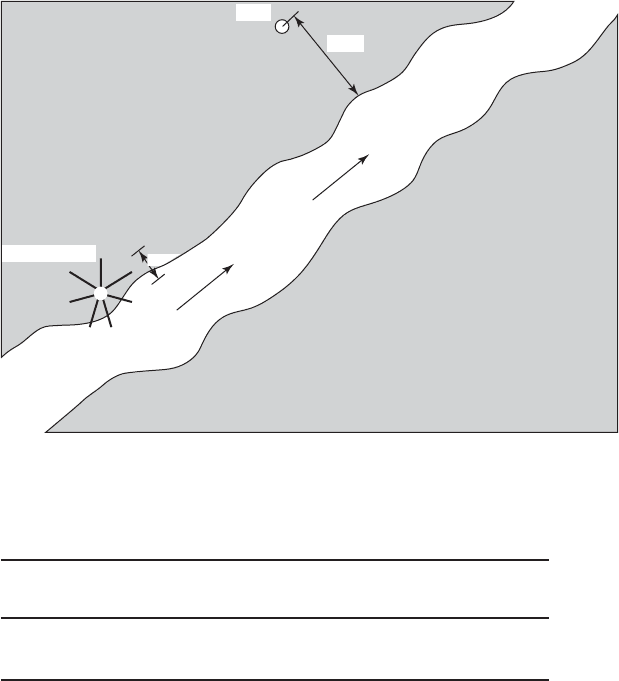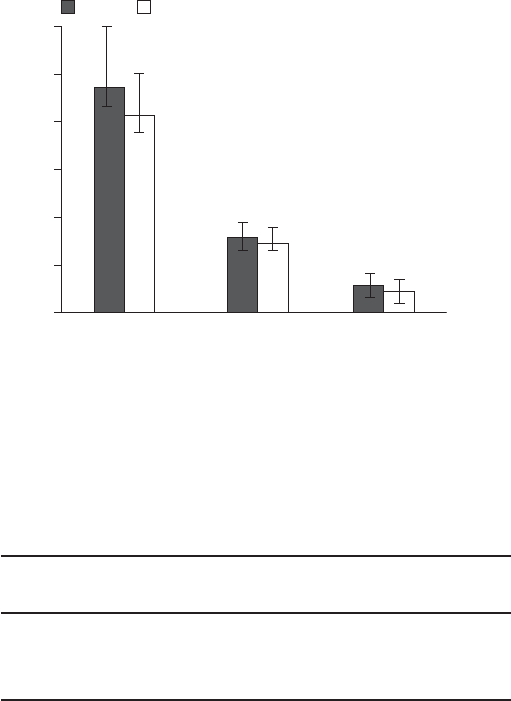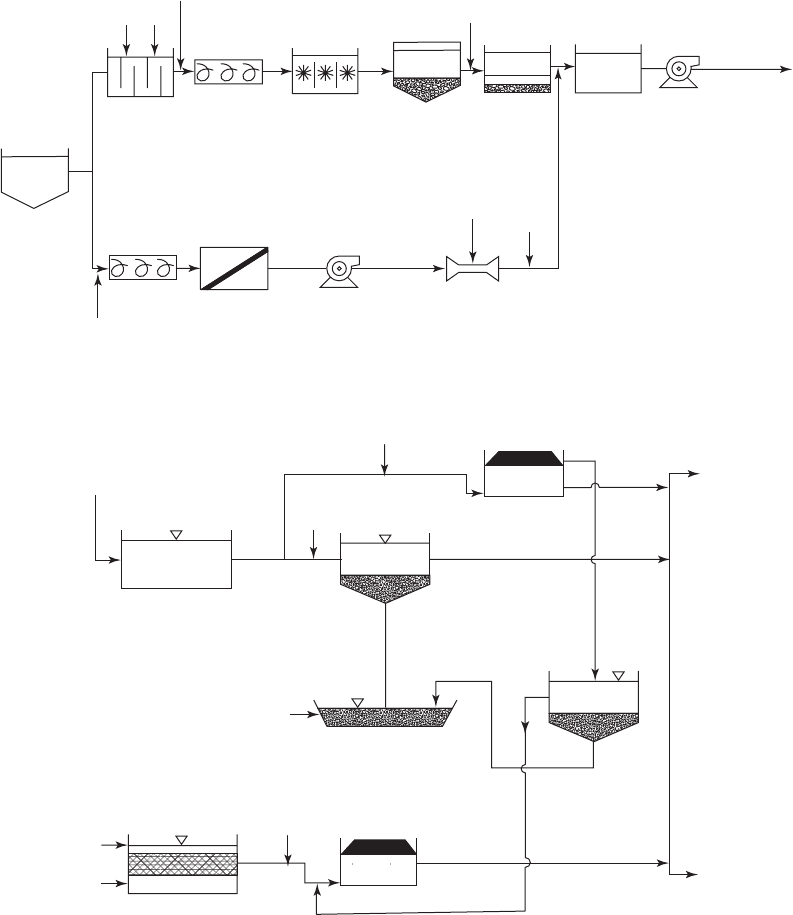Water and Wastewater Engineering
Подождите немного. Документ загружается.


16-8 WATER AND WASTEWATER ENGINEERING
These factors are discussed in the following paragraphs.
Contaminant Removal. Rem oval of contaminants is the primary purpose of most treatment
processes . In the United States, the regulations promulgated by the U.S. Environmental Protec-
tion Agency set the maximum allowable contaminant levels (MCLs). Obviously, processes that
cannot achieve the MCL for a single contaminant or group of contaminants can be quickly elim-
inated. For example, if arsenic is the sole contaminant constituent of concern, a quick review
of Table 16-1 reveals that MF and UF mem branes are not an option that should be cons idered.
However, Table 16-1 is not the be all, end all in the sc
reening process. While the table shows
seven other options that should be considered, the tables and decision trees in Chapter 14 pro-
vide a much more refined list of options and guidance in making choices for arsenic removal.
Many utilities choose to produce water that is much better in quality than that required
to
comply with the regulations. This includes improving the aesthetic characteristics of the water.
Many of the processes that are needed to provide the water qu ality required to meet the regula-
tions may be operated in a manner that yields a higher quality than is required by the regulations.
One way to get higher quality is
to operate at lower loading rates than the customary norms. An-
other way is to provide additional treatment processes.
Source Water Quality. In the simplest view, a comparison of the sourc e water quality and
the desired finished water quality set the required degree of treatment. The variation in the
source water quality must be within the range of quality that the treat
ment plant can success-
fully treat.
Process or
contaminant
Table or
figure number Remarks
Arsenic Tables 14-1, 14-2, 14-3
Figures 14-1 & 14-2 Decision tree & graph
Disinfection Tables 13-4, 13-5, 13-6,
13-7, 13-9, 13-10
Figures 13-9, 13-10 Decision trees
GAC Table 14-10
Iron & Manganese Figures 14-5 & 14-6 Decision trees
NF/RO membranes Table 9-1
MF
/UF membranes Table 12-1
Radium Table 14-7
Residuals
ArsenicFigures 15-13 & 15-14 Decision trees
Liquid Table 15-10
Figures 15-11 & 15-12 Decision trees
Radioactive Figures 15-15 & 15-16 Decision trees
Sludges Table 15-4 Lime & coagulation
TABLE 16-4
Summary of tables and figures to aid in screening alternatives
DRINKING WATER PLANT PROCESS SELECTION AND INTEGRATION 16-9
In some cases, the characteristics of the raw water suggest the need for a particular treatment
process. An example is the use of dissolved air flotation (DAF) in treating algae laden water or
greensand to treat groundwater with high concentrations of iron.
Often a c ommunity will use multiple sources for their water s upply. While this make
s the
decision process even more complex, it offers opportunities for blending to dampen fluctuations
in raw water quality as well as improving reliability of the source.
Reliability. As used here, the term reliabi lity includes robustness as well as mean time be-
tween failures
. Robustness includes the ability to handle changes in raw water quality, on-off
cyclic operations, normal climatic changes, adverse weather events, and the degree of mainte-
nance required to maintain efficient operation. Althou gh minimum redu ndancy requirements
(e.g., Table 1-3) help to ensure reliability, they do not take into acco
unt failures becau se the
equipm ent is operated outside of its normal operating range or failure to meet water quality
goals becaus e of frequent or very long down time for repairs.
Existing Conditions. Upgrades and expansion of existing facilities requires careful evaluation
of the existing process and the constraint
s of the site. Hydraulic requirements may often limit the
choices in process selection and design configuration.
Process Flexibility. The ability of the operator to mix and m atch various processes to adapt
to variations in demand ranging from minimum demand at initial start-up of the plant to m
ax-
imum demand at the design life is essential to providing consistently good quality water. In
addition, the ability to “work around” scheduled out-of-service maintenance requirements as well
as unscheduled maintenance for repair of failures should be planned
in the selection of process
options. Both the plant layout and the hydraulics of the plant play a role in providing this flex-
ibility. These are discussed later in this chapter.
A more difficult requirement is the flexibility to meet changing regulatory requirements (which,
generally, will become more stringent rather than less stringent) or change
s in the source water
characteristics. For a given set of site characteristics, planning for future expansion is one logical
way to provide flexibility. In some cases it may be possible to provide extra space in the hardened
facilities (i.e., concrete structures) to allow for addition of equ
ipment when the need arises. Provid-
ing access doors or roof structures to the space is also a good idea. There is, of course, the risk that
the space will never be needed.
Utility Capabilities. The water utility must be able to operate the plant once it is built. This
includes repairs as well as day-to-day ad
justments, ordering supplies , taking samples, and so
on. Processes should be selected that can be operated and maintained by available personnel or
personnel that can be trained. The plant management must be informed of the complexities and
requirements of the treatment process before plans
are adopted. Staff training, as well as avail-
ability and access to service, are important considerations in selecting a process.
For many small (501 to 3,300 people) and very small (25 to 500 people) communities and
even some medium (3,301 to 10,000) to very large (100,000 people) communities, there are
economies of sc ale in joining with others to provide treated water. The economies of scale are
found primarily in capital cost, outside services, and materials. Energy and, to a lesser extent,
16-10 WATER AND WASTEWATER ENGINEERING
labor costs do not exhibit as significant an economy of scale (Shih et al., 2006). Based on survey
data, Shih et al. found that the median unit production cost (operating cost plus depreciation in
$/m
3
of water delivered) for a very small plant was 135 percent greater than that for a very large
plant. On the other hand, 20.7 percent of very small plants and 22.0 percent of medium-sized
plants had a unit cost lower than the median unit cost of very large plants. Thus, larger size does
not guarantee lower costs. In addition to the political issues of local control, a caref
ul economic
evaluation of the alternative of joining with another community is warranted.
Costs. The capital cost may be the key factor in selection of a process. As noted in Chapter 1,
the operating cost is, in all likelihood, equally relevant. It may be even more important than capi-
tal cost in the decision process because of the rising cost of energy an
d labor.
Environmental Compatibility. The issues included under this heading range from residuals
disposal to the wastage of water in the treatment process. Advanced processes that generate re-
sidu als with high concentrations of materials that are d ifficult to dispose of may be sufficient
reason to reject the
m. Likewise, processes that reject large quantities of water with respect to the
quantity of water produced should be reviewed carefully. This is especially true in areas where
water supplies are limited.
Process Selection Examples
The following three case studies were selected from the literature to demonstrate the wide range
of choices and some of the logic that was used in making the choices. The cited references pro-
vide more detail. A literature review of the many other examples that are reported in the Journal
American Water Works Association and Opflow
(also published by the American Water Works
Association) should be part of any study to evaluate process alternatives.
Case Study 16-1
Groundwater sources that are hydraulically connected to a surface water source mus t comply
with EPA’s rules under the category called “groundwater under the influence of surface water,”
more frequently cited as “groundwater
under the influence.” Although this designation imposes
requirements for water quality that are not normally applied to groundwater, the use of wells “un-
der the influence” may have significant advantages over direct withdrawal from surface water.
This source of water is often referred to as river bank filtrat
ion or just bank filtration.
The effec tiveness of bank filtration has long been recognized in Europe. Many utilities are
interested in bank filtration in the United States because it has the potential to remove pathogenic
microorganisms and reduce disinfection byproduct precursors.
Discussion. The paper by Weiss et al. (2003) was selected to illustrate a c o
mparison of three
sources for a water supply: a river, a horizontal collector well, and a vertical well located 122 m
from the river.
The river is the Wabash River at Terre Haute, Indiana. The site is sketched in Figure 16-2 .
The characteristics of the collector well and the individual well are as shown in Table 16-5 .

DRINKING WATER PLANT PROCESS SELECTION AND INTEGRATION 16-11
The average total organic carbon (TOC) and dissolved organic carbon (DOC) for each source
are shown in Figure 16-3 .
T h e Clostridium and E. coli C bacteriophage concentrations for each source are given in
Table 16-6 .
Both the collector well and the vertical well achieved a remarkable improvement in the
source water quality over direct withdrawal fro
m the river.
Comments:
1 . Not investigated in the paper by Weiss et al. were several other potential effects of bank
filtration (Tufenkji, Ryan, and Elimelech, 2002):
a . When there is intense microbial activity in the river bed sediments, the oxygen is de-
pleted and anoxic conditions result.
b . Microbial activity under anoxic conditions
results in reduction of the nitrate
concentration.
Collector well
Well
122 m
Wa
s
bas
h River
27 m
FIGURE 16-2
W a b a sh River at Terre Haute, Indiana.
Well ID
Depth to
well screen, m
Well screen
length, m
Well capacity,
m
3
/d
Collector 24
480
a
45,500
Well No. 3 45 14 3,760
TABLE 16-5
Characteristics of the wells at Terre Haute, Indiana
a
Ranney screen.

16-12 WATER AND WASTEWATER ENGINEERING
c . If the aquifer becomes highly reduced, manganese and iron are mobilized, which may
result in a deterioration of the water quality. If the well system is at the outer limit of the
surface water–groundwater interface, oxidation results in precipitation of these metals.
d . Microbial degradation of organic matter mobilizes metal
s such as copper and cadmium.
e. Excessive microbial growth may decrease hydraulic conductivity at the surface water–
groundwater interface as a result of biofilm formation.
2. The effects of grou ndwater dilution as well as the subsurface filtration as
pects of river
bank filtration are assessed in a paper by Partinoudi and Collins (2007).
Case Study 16-2
The Milwaukee Cryptosporidium o utbreak in 1993 had a major impact on process selection for
both new construction and upgrades. This coupled with U.S. EPA’s increasingly stricter drinking
water regulations is influencing utilities to consider low-pressure membrane (MF and UF) as
part
of their multibarrier treatment train.
Wabash River
6.0
5.0
4.0
3.0
2.0
1.0
0.0
Collector well
Well 3
TOC DOC
TOC or DOC—mg/L averaged over sampling dates
DOC—dissolved organic carbon, TOC—total organic carbon
Number of sampling events 16 for DOC, 19 for TOC
FIGURE 16-3
Average TOC and DOC concentrations at Terre Haute, Indiana.
( Source: Weis et al., 2003.)
Location
Clostridium
average counts/100 mL
E. coli C
pfu/100 mL
Wabash River 183 147
Collector well 0.07 0.07
Well 3 0.07 0.07
TABLE 16-6
Clostridium and E. Coli concentrations at Terre Haute, Indiana

DRINKING WATER PLANT PROCESS SELECTION AND INTEGRATION 16-13
Discussion. Shorney-Darby et al. (2007) present a detailed explanation of the evaluation of MF
membranes for expansion of the Modesto Regional Water Treatment Plant (MRWTP) in central
California. The existing 136,000 m
3
/ d plant was a conventional system that employed ozone dis-
infection, alum coagulation, flocculation, sedimentation , and deep-bed monomedium filtration to
treat water from the Modesto Reservoir. The plant was commissioned in 1995 and has operated
well. The original design incorporated features for expansion to 273
,000 m
3
/ d using the same pro-
cesses of conventional treatment. Table 16-7 summarizes the raw water and filter effluent quality.
In the summer months, when there are few rain events in central California, turbidity and TOC
concentrations are stable and low in the raw water supply (5 NTU and 1.3 mg/L, respectively).
During the rainy winter months, the turbidity can rea
ch 20 NTU and TOC concentrations can
double.
The screening process for the expansion project was limited to two choices: replication of the
existing plant and construction of a parallel MF plant. Because the conventional plant was well
known, the study focused on the implications of a new MF plant. The particular concern was the
higher turbidity and TOC in the winter.
A pilot study was cond
ucted to see if pretreatment (e.g., coagulation, flocculation, and set-
tling) would be required to achieve satisfactory operation. The main conclusions from the pilot
testing were the following:
• Low-pressure mem branes can effectively treat Modesto Reservoir water at a reasonable
water flux with reasonable cleaning intervals;
• No pretreatment upstream of the membranes
is necessary; and
• The membrane train can operate for several months each year without coagulant but low dos-
ages of alum ( 8mg/L) may have to be used to lower TOC concentrations in the rainy season.
The 20-year present worth cost estimates for the conventional plant and the MF plant dif-
fered by less
than 10 percent. This fact, coupled with favorable pilot testing led to the decision to
proceed with the MF option. This decision was facilitated by the recognition that the MF plant
would allow for future expans ion while the construction of a parallel conventional plant would
use all of the available land.
The final treatment train arrangement is shown in Figure 16-4 .
Parameter Raw water Filter effluent
Turbidity, NTU 1.5 to 19.4 0.015 to 0.130
Total organic carbon mg/L 1.1 to 3.4 0.78 to 2.2
Total coliform, MPN/100 mL 0 to 1,733 0
Fecal coliform, MPN/100 mL 0 to 300 0
Cryptosporidium, counts/100 mL
0 to 0.05 N/A
Giardia, counts/100 mL
0 to 0.02 N/A
Algae, cells/ mL625 to 38,750 N/A
pH 5.9 to 7.4 8.1 to 9.0 (finished
water)
Temperature, C4.5 to 21
TABLE 16-7
Range of MRWTP water quality data: January to April, 2007
A dapted from Shorney-Darby et al., 2007.

16-14 WATER AND WASTEWATER ENGINEERING
Alum
NaOH
Static
mixer
Ozone
contactor
Flocculation
basins
Sedlmentation
basins
Stabilization
basins
Filters
(deep bed
monomedium)
Pump
O
3
CaS
2
O
3
CaS
2
O
3
NaOCL
Modes to
Reservoir
NaOCL
Flume
contactor
Pump
Membranes
Static
mixer
Alum
FIGURE 16-4
Parallel conventional (top) and membrane (bottom) treatment trains for expanded Modesto Regional Water Treatment Plant.
FIGURE 16-5
R e siduals treatment trains for expanded Modesto Regional Water Treatment Plant.
Underflow
Underflow
Underflow
Recycle to
membrane
train
Sludge
wet well
Sludge lagoon
Sedimentation
basin sludge
Alum &
polymer
DAF
Recycle to
conventional
train
DAF
Alum &
polymer
Alum &
polymer
Solids
thickener
Conventional
filter
backwash
Washwater
recovery
basin
Membrane
backwa
sh
Neutralized and
treated CIP waste
Membrane
backwash
equalization
basin
Residuals handling in the new plant configuration required carefu l planning. Because the
polymers used in thickening the conventional treatment residuals potentially could damage the
membrane via the recycled decant water, separate handling systems were used ( Figure 16-5 ). In

DRINKING WATER PLANT PROCESS SELECTION AND INTEGRATION 16-15
addition, recycling of MF clean-in-place (CIP) chemicals was found to disrupt the coagulation
and sedimentation processes. Some of the CIP chemicals will be neutralized and returned to the
head end of the plant. Others will be hauled off-site for disposal.
Comment. A major disadvantage of us
ing the MF for the expansion is that, in effect, there
are two plants to operate: a conventional plant and a MF plant. This implies that operators with
exceptionally diverse skills must be employed or two, almost independent staffs have to be pro-
vided. In addition, with the exception of alum, two different sets of chemicals must be stored and
maintaine
d.
Case Study 16-3
A s noted in Chapter 2, groundwater has many characteristics that make it preferable as water sup-
ply. But it is not without drawbacks, including high concentrations of manganese, iron, hydrogen
sulfide, or ammonia.
Discussion. Sled and Pierson (2007) describe the treatment objectives and processes sele
cted
for the upgrade of the Renton, Washington water treatment plant. The raw water quality charac-
teristics are described in Table 16-8 .
The treatment objectives for the new treatment plant were:
• Eliminate customer complaints about manganese staining of clothes and fixtures.
• Produce treated water with a free chlorine residual.
• Improve the taste and o
dor of the water.
• Eliminate hydrogen sulfide odor in the ambient air that occurred with the previous air strip-
ping process.
• Increase the dissolved oxygen to match that of the city’s other water supplies.
• Meet the pH requirements for continued compliance with the Lead and Copper Rule.
The treatment objectives were quantified by
selecting the water quality objectives shown in
Table 16-9 .
The major components of the new treatment process are granular activated carbon (GAC)
for hydrogen sulfide removal, greensand for manganese and iron removal, and breakpoint
Parameter Range of values
Ammonia, free, mg/L 0.35 to 0.55
TOC, mg/L 0.46 to 1.9
Total iron, mg/L 0.0 to 0.04
Total manganese, mg/L 0.07 to 0.12
Sulfide, mg/L 0.06 to 0.20
pH 7.6 to 8.0
TABLE 16-8
Renton, Washington raw water quality characteristics
Adapted from Sled and Pierson, 2007.

16-16 WATER AND WASTEWATER ENGINEERING
chlorination for ammonia reduction. Three 3.6 m diameter GAC columns and three 3.6 m
diameter greensand filters are used in the plant. This provides a capacity of 16,000 m
3
/ d. Space
is provided to add two more GAC columns and two more greensand filters to bring the capacity
to 30,000 m
3
/ d. Sodium hypochlorite is used for breakpoint chlorination. Contact is provided in
an underground clearwell that is provided with serpentine baffle walls.
Comments:
1 . The translation of the treatment objectives into quantitative measures is an excellent way
to assess the capability of alternative processes.
2. The provision of “hardened” s
pace for expansion gives Renton flexibility for the future.
3. The paper presents many worthwhile lessons learned for consideration in start-up of a new
facility of this type as well as suggestions for training programs with new equipment.
16-3 PROCESS INTEGRATION
Plant Layout
The available land area and topography dictate the plant layout. The conceptual framework for
the plant layout begins with the process flow diagram ( Figure 16-6 ). The process flow diagram
should include the following items (Kawamura, 2000):
1 . All the unit processes in the correct sequence.
2. All the major pipe connections with flow directions.
3. All the chemicals that are to be used and the application points of each.
4. All the major sampling points.
5. The location and size of all major flow meters, valves, and connecting pipes.
6. The location of all major pumps, blowers, and screens.
7. The control points for pressure, water level, flow rate, and water quality.
The basic
s tyles of plant layout are the linear style, compact style, and campus style
( Figure 16-7 ). In general, the linear and campus styles have several advantages over the compact
Parameter Treatment objective
Ammonia, free, mg/L 0.025
Total iron, mg/L 0.05
Total manganese, mg/L 0.01
Sulfide, mg/L 0.0003
pH 7.6 to 8.0
TABLE 16-9
Renton, Washington treated water quality objectives
A dapted from Sled and Pierson, 2007.

16-17
GAC
Filter
control
structure
Filters
Influent
screening
Influent
pumping
KMnO
4
,
PAC
Flow
monitoring
pH
monitoring
Turbidity
monitoring
Flash
mixer
Lime, alum or
iron salt
KMnO
4
, PAC Cl
2
Flash mix
chamber
Flocculation basins
Sedimentation basins
To disposal
Sludge
To disposal
Recycle
pump
Level
monitoring
Cl
2
HWL
LWL
Level
monitoring
Turbiditty, chlorine
(or other
disinfectant)
residual and pH
monitoring
Chlorine (or other
disinfectant)
residual and pH
monitoring
Cl
2
corrosion
inhibitter
To city
distribution
High lift
pumps
Turbidity
monitoring
Headloss
monitoring
Supplemental
backwash wate
r
Flowmeter
Chlorine contact
and clearwall
Flow
monitoring
Effluent
flow meter
Cl
2
, NaOH,
corrosion inhibitor
floride
Reservoir
Sludge
Waste
washwater
holding basin
FIGURE 16-6
E xample of a process flow diagram.
